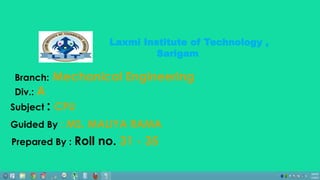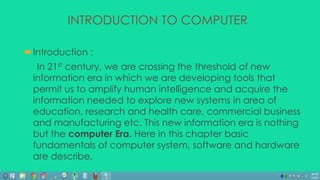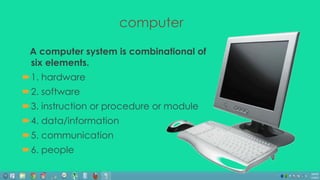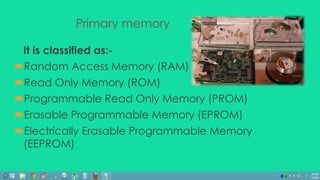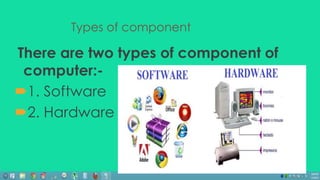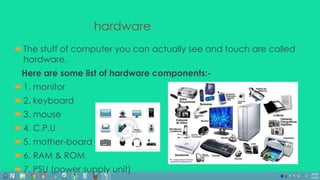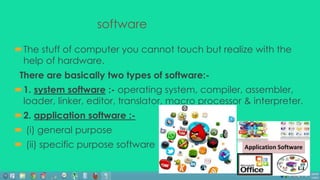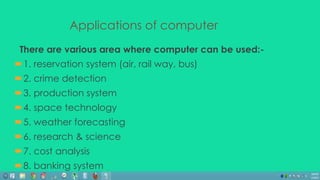Cpu introduction to computer
- 1. LAXMI INSTITUTE OF TECHNOLOGY, SARIGAM INTRORUCTION TO COMPUTER (CPU)
- 2. Laxmi Institute of Technology , Sarigam Branch: Mechanical Engineering Div.: A Subject : CPU Guided By : MS. MALIYA RAMA Prepared By : Roll no. 31 - 35
- 3. BRANCH - MECHANICAL-A ACADAMIC YEAR – 2014-2015 SUBJECT - CALCULAS SEM. – 1 31- FARUKH SHAIKH 32- RAVINDRA YADAV 33- AKSHAY AHIRE 34- KRUPAL BHANDARI 35- YASH PAWAR 140860119105 140860119123 140860119004 140860119 140860119
- 4. INTRODUCTION TO COMPUTER Introduction : In 21st century, we are crossing the threshold of new information era in which we are developing tools that permit us to amplify human intelligence and acquire the information needed to explore new systems in area of education, research and health care, commercial business and manufacturing etc. This new information era is nothing but the computer Era. Here in this chapter basic fundamentals of computer system, software and hardware are describe.
- 5. computer It is an electronic device which accept data from out side world ( standard input device ) and manipulates and process it according to instruction given at high speed. It has memory to store large amount of data, can process it in accurate form with high speed by using power full processor. Computer is also called data processor because it can store, process and retrieve data when ever required.
- 6. A computer system is combinational of six elements. 1. hardware 2. software 3. instruction or procedure or module 4. data/information 5. communication 6. people computer
- 7. Basic block diagram and function of computer components: Basic block diagram of computer system is given below. There are basic five components which are 1. central processing unit (CPU) (ALU and CU) 2. memory 3. input device 4. output device 5. secondary storage device
- 8. Central processing unit (CPU) The central processing unit (CPU), some times referred to as “brain” of the system, is main part of computer system that contain electronic circuitry that actually process the data. It also controls the flow of data through the system. The CPU consists 1. ALU (Arithmetic logic unit) 2. CU (Control unit)
- 9. cpu 1. ALU: Here actual execution instruction take place during processing operation. It performs all arithmetic calculations and take logical decision. It can compare, count, shift or other logical activities. All such calculations and comparisons are done in this unit and return information (process data) to memory unit if storage require. It calculate very fast.
- 10. Cpu 2. CU : It manages and coordinates operations of all other components of computer system. It also perform following functions. It retrieve instruction or data from memory. It decode instruction It coordinate time sequence of instruction among various component of system It determine requirement of storage and take action according to it It also fetch instruction from main memory.
- 11. Memory unit The storage unit of computer system store data for following purposes. Processing data and instructions. Storage of temporary result (intermediate data storage) Permanent storage for future requirement (secondary storage) There are two types of storage. 1. primary storage 2. secondary or auxiliary storage
- 12. Primary storage (user ram) The main function of primary storage are … Store current program or data (running program) It also store temporary data of current program Less space in comparison of secondary storage Volatile (data losses on power off) Comparatively more expensive Fast in operation
- 13. Primary memory It is classified as:- Random Access Memory (RAM) Read Only Memory (ROM) Programmable Read Only Memory (PROM) Erasable Programmable Memory (EPROM) Electrically Erasable Programmable Memory (EEPROM)
- 14. Secondary or auxiliary memory The main function of secondary storage are … Used to store program and data for future usage Large capacity (GB) in comparison with primary memory Slower than primary memory Retain data without power Cheaper than primary memory
- 15. Secondary memory It also called as external memory hard disk (HDD) floppy disk cd dvd removable hard disk pen drive
- 16. Input/output device Entering data or information into a computer is called input. An input device is a device which enters data or information into a computer. Information we get from computer is known as output. Output device return processed data that is information back to the user. An output is a peripheral that convert machine readable information into people readable form.
- 18. Limitation of computer computer cannot identify any input / output by itself for solving problem it cannot make any decision related problem, solution formula must be given it cannot make any decision on the base of experience it can not interpret the data store in to storage media in different aspects as per situation for every solution rules or procedure or sequence needed.
- 19. Types of component There are two types of component of computer:- 1. Software 2. Hardware
- 20. hardware The stuff of computer you can actually see and touch are called hardware. Here are some list of hardware components:- 1. monitor 2. keyboard 3. mouse 4. C.P.U 5. mother-board 6. RAM & ROM 7. PSU (power supply unit)
- 21. software The stuff of computer you cannot touch but realize with the help of hardware. There are basically two types of software:- 1. system software :- operating system, compiler, assembler, loader, linker, editor, translator, macro processor & interpreter. 2. application software :- (i) general purpose (ii) specific purpose software
- 22. Programming languages It is classified as :- 1. machine language or low language 2. middle level language 3. high level language 4. object oriented
- 23. Applications of computer There are various area where computer can be used:- 1. reservation system (air, rail way, bus) 2. crime detection 3. production system 4. space technology 5. weather forecasting 6. research & science 7. cost analysis 8. banking system


